An innovation pipeline refers to the stages ideas pass through from conception to implementation.
A well-managed innovation pipeline enables companies to reliably collect and develop new ideas into solutions that drive growth.
We've served as innovation consultants within enterprises for 15 years and seen many companies make crucial errors when setting up their innovation pipelines, preventing them from seeing progress.
To address these errors and assist companies in realizing ROI from innovation, we wrote this guide covering the five stages in the innovation pipeline and the best practices that worked well for us when setting up each stage.
We also explain how InnovationCast, our own innovation management platform, supports the creation and management of innovation pipelines that achieve business growth.
Reach out for a 25-minute demo and learn how InnovationCast can establish an innovation pipeline within your organization in under four weeks.
1. Idea Generation
The first stage in the innovation pipeline involves collecting high-quality ideas that align with the company’s priorities.
When collecting ideas, we recommend utilizing the creative brainpower and perspectives of the entire workforce, as we’ve seen that broader participation leads to stronger ideas than relying on only a select group. To achieve this, companies must provide all employees with a means to share their ideas.
However, the mistake we see is reducing idea generation to little more than a Slack or Microsoft Teams channel or a webform and asking employees to drop in their suggestions. There are three problems with this:
Employees share irrelevant ideas: Since employees have limited visibility into the company’s focus areas, they tend to share ideas that may seem exciting or innovative to them but don’t align with the company. Idea evaluators table most ideas, and employees stop participating out of frustration.
Employees say they’ll share ideas when they find time, which is never: Because the idea box remains open indefinitely, employees procrastinate. Companies struggle to collect ideas, and innovation pipelines stall.
Employees are skeptical because they’ve seen similar initiatives rolled out before with little follow-through: Employees think their ideas won’t lead to action, so they see no point in sharing them.
We encourage being more calculated with idea generation. Instead of having an open call for new ideas, clarify the company’s focus areas first. Innovation managers should consult relevant stakeholders (e.g., head of product development, marketing, operations, sales, etc.) to understand what matters most.
Once innovation managers have a firm grasp of core priorities, they should create challenges targeting each one. A challenge is a post with context on a specific topic, accompanied by an invitation for employees to contribute fresh ideas before a certain date.
Challenges funnel the ideation and innovation efforts of the whole workforce into a select few priorities, solving the limitations of open idea boxes:
Employees are aware of the company's priorities and limit their idea submissions to those subject matters.
Challenges have deadlines, so employees must get involved quickly if they want their ideas chosen.
Using innovation management software, companies can give employees transparency into what’s happening to their ideas. This shows employees that their ideas are being evaluated, tested, and potentially implemented.
How InnovationCast Drives Targeted Idea Generation
As part of the onboarding process, we will learn about your company’s focus areas and use that information to create high-quality Innovation Challenges. You don’t have to write and design postings on your own, as with most platforms.
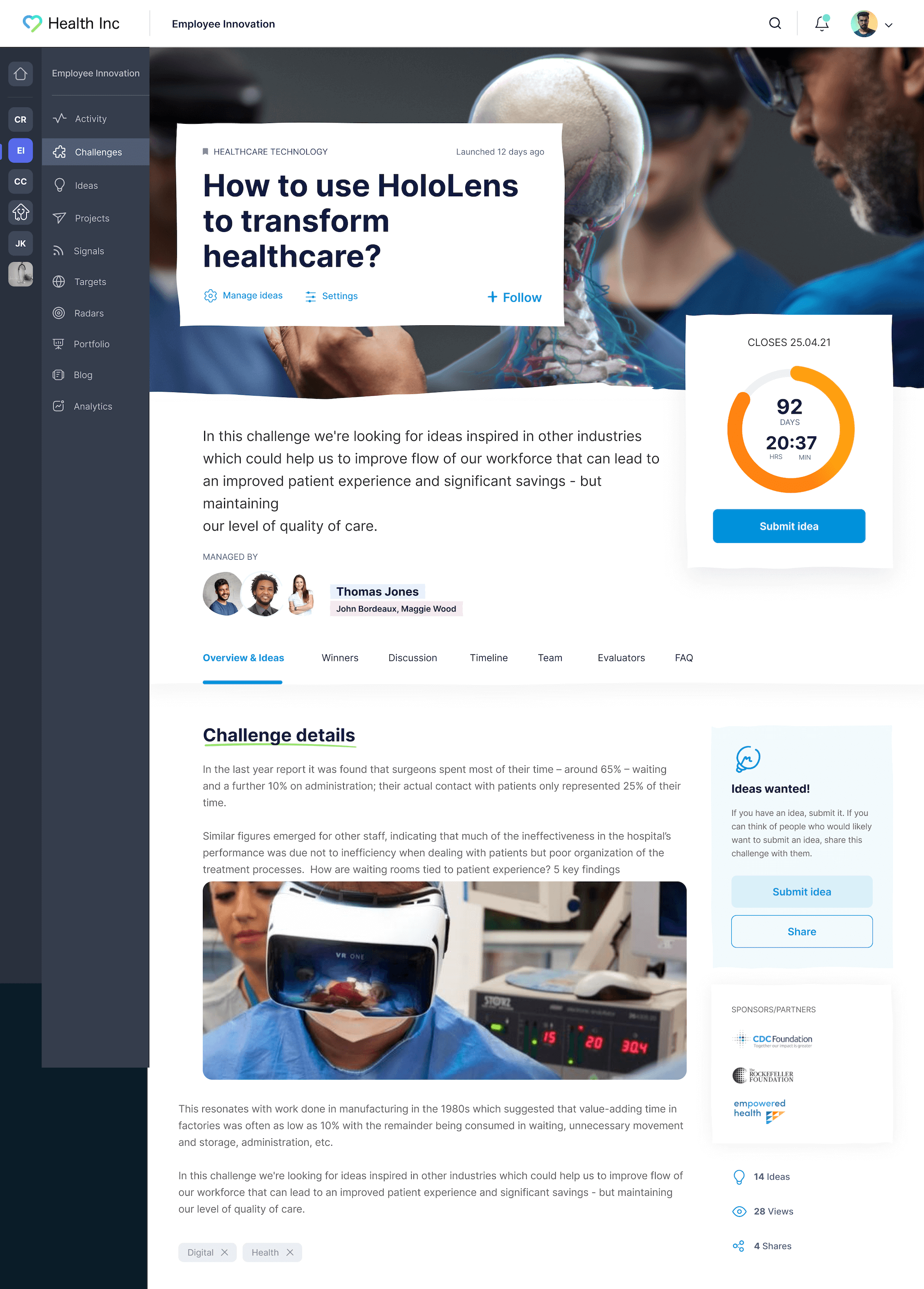
Once challenges are published, the InnovationCast platform automatically sends invitations to relevant users, asking them to submit great ideas.
InnovationCast also has an AI-powered duplicate checker that scans each idea. If the AI detects that it’s similar to what someone else has shared, it asks the employee to collaborate with the existing author and build upon their idea instead of sharing a duplicate. This prevents evaluators from having to filter through duplicate ideas.
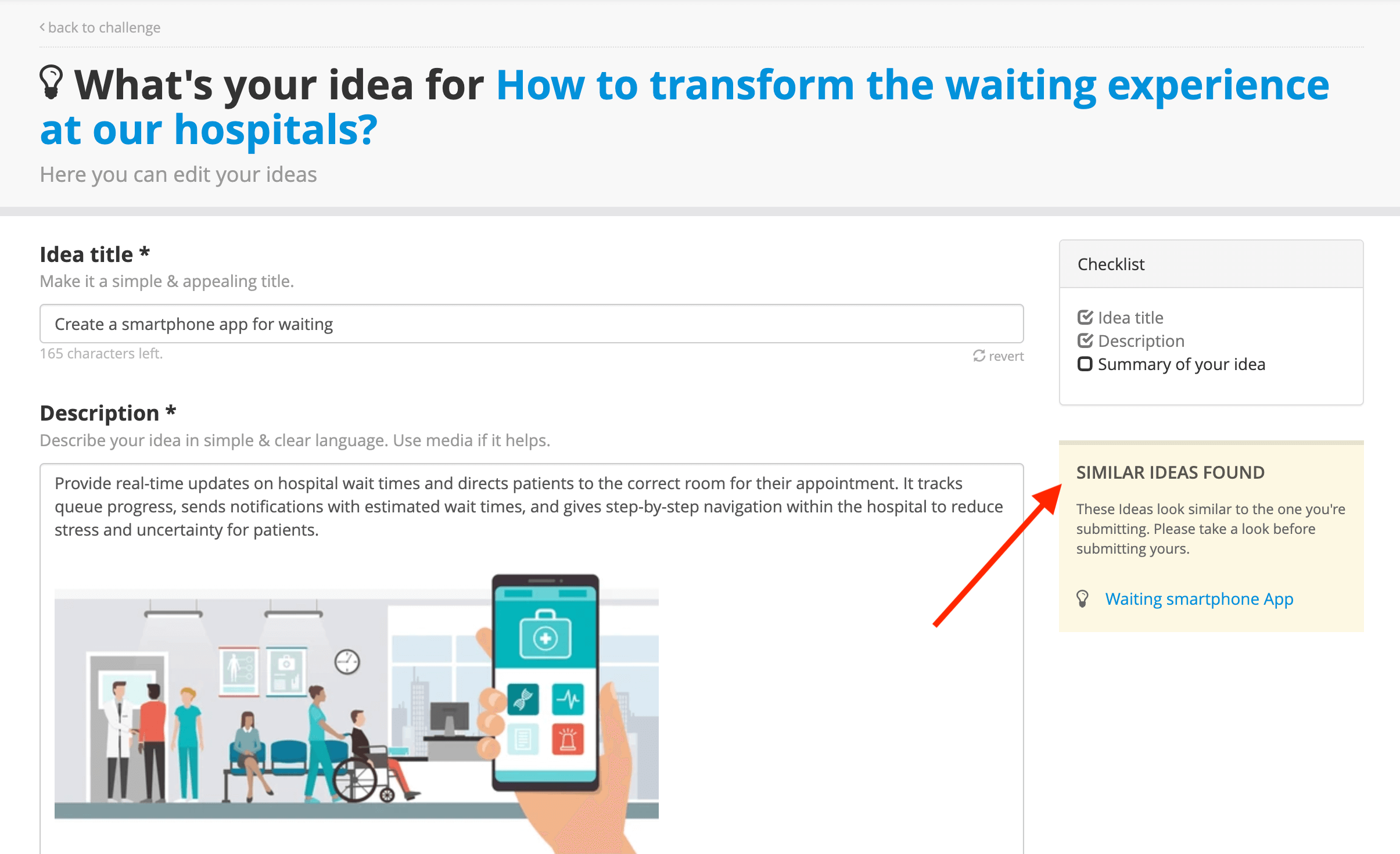
For busier employees who may not have time to brainstorm and research ideas, they can use our Signals & Scouting feature to share relevant news stories, competitor press releases, government regulation changes, and more by simply clicking a button in their browser.
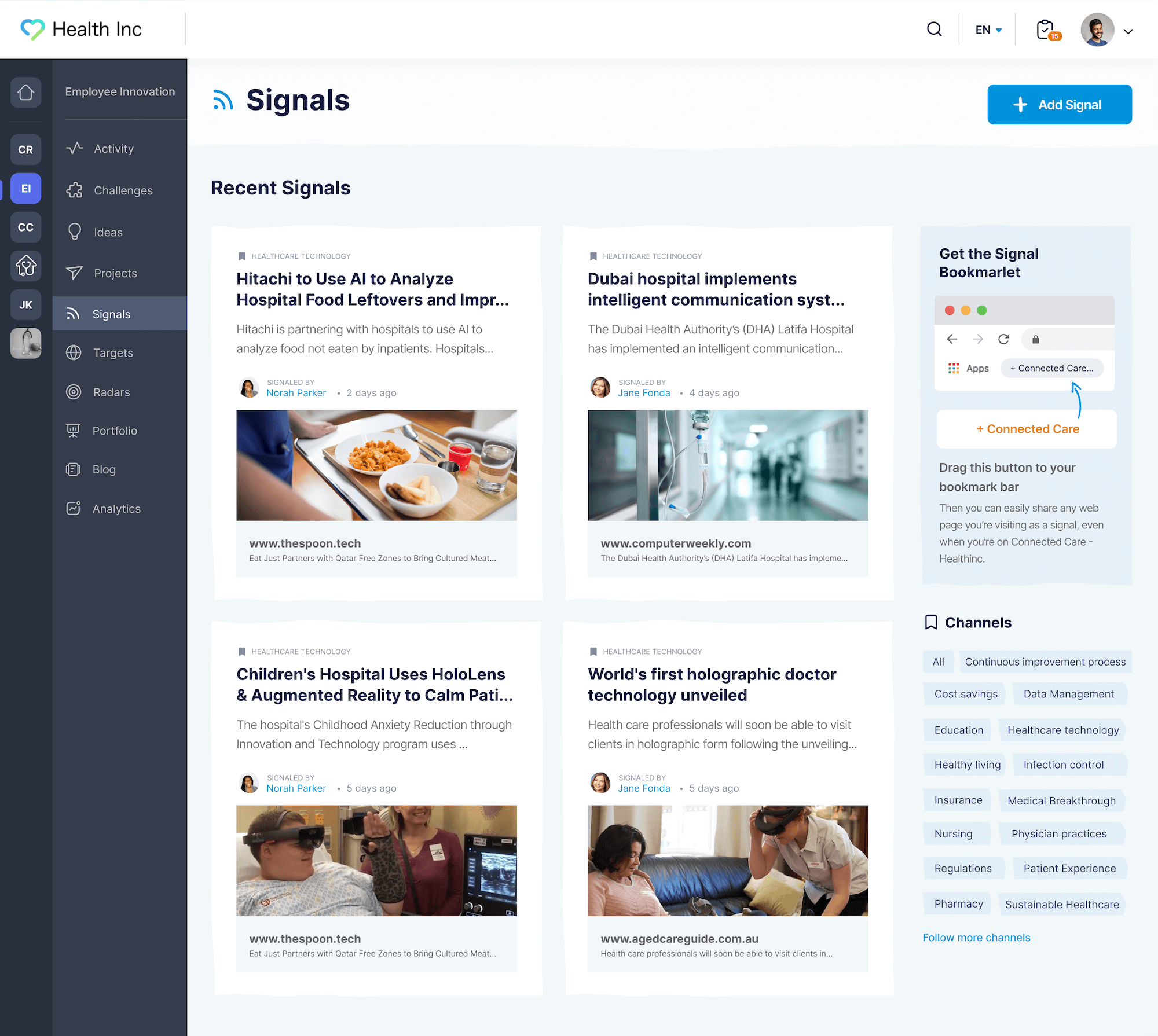
Once employees submit ideas or Signals, they have complete transparency into their progress. They can track how evaluators score their ideas, see the actions validation teams are taking to de-risk them, and find out whether their ideas were ultimately implemented. This transparency reassures employees that their time spent brainstorming and contributing ideas is genuinely valued.
Read more: 5 Detailed Innovation Challenge Examples & Best Practices
2. Idea Refinement
When addressing complex organizational priorities, such as expanding into adjacent markets or protecting against disruption, it’s unfeasible to think that just one author has all the required skillsets to brainstorm and refine a solution on their own.
Solving these complex problems requires multiple stakeholders, diverse perspectives, and complementary competencies working together and considering ideas from different angles. Engineers may need to provide input on how an idea functions technically or scales operationally, while a marketer may need to evaluate how it resonates with customers’ needs.
However, the way most companies crowdsource ideas makes this refinement step impossible because there is no centralized platform where employees across departments can see each other’s ideas, co-create, and build upon them.
Without idea refinement, companies collect poorly thought-out, unrefined ideas that must be terminated.
In our experience, companies with the most successful innovation pipelines promote cross-departmental co-creation to refine ideas after they have been collected. Employees can view ideas shared by their colleagues and lend their expertise to refine them.
How InnovationCast Allows Companies to Improve Ideas Using the Brainpower of Their Entire Workforce
When an employee responds to a challenge with an idea, it’s automatically posted to the activity feed for peer visibility.
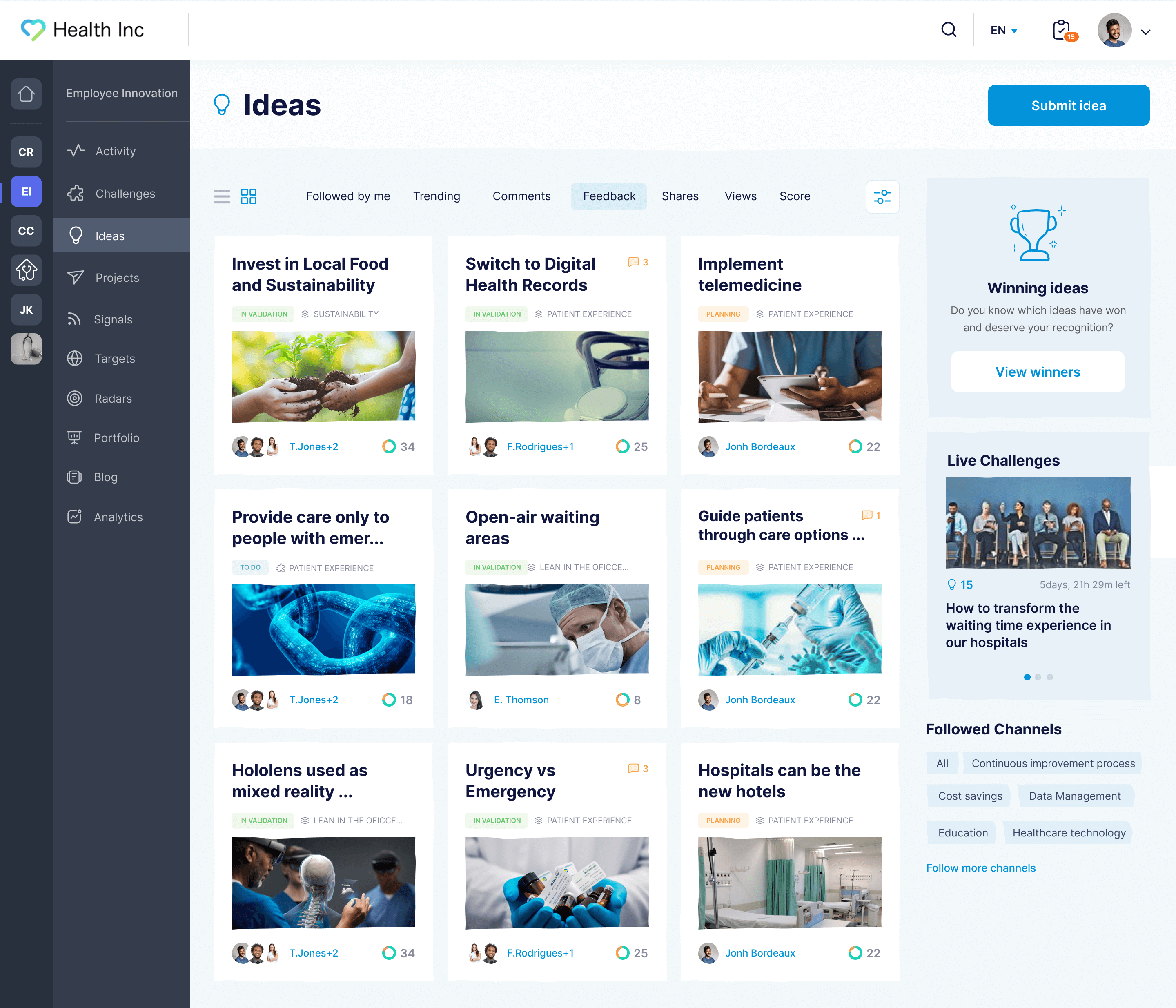
Users can click on an idea and view all the context, data, and evidence the author added. They can vote, share their thoughts, ask questions, give constructive feedback, and refine ideas. Idea authors can also leave requests for feedback on specific aspects of their ideas and tag colleagues.
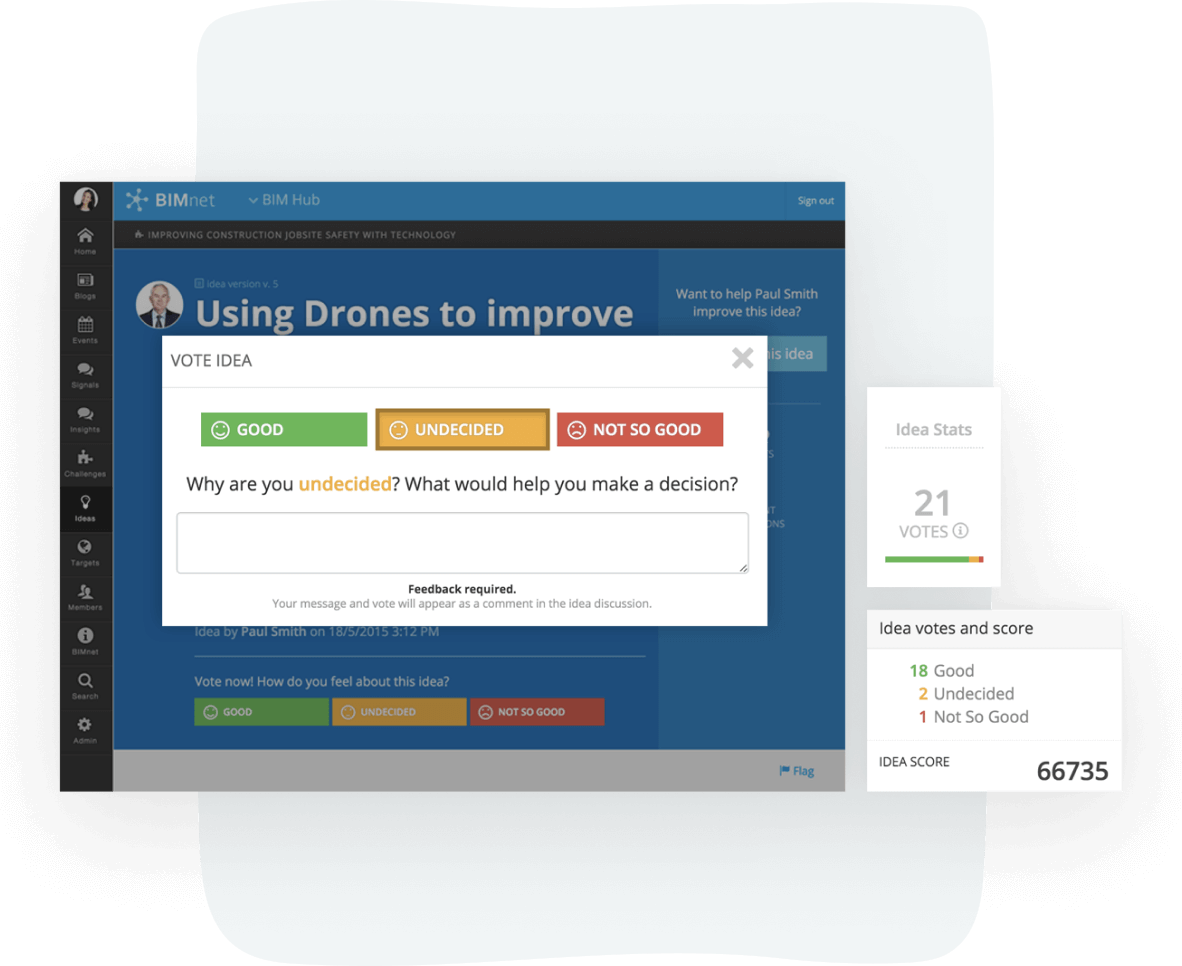
As authors and co-creators refine and edit their ideas, InnovationCast tracks and saves each version, allowing users to see how the idea evolved over time and the feedback that influenced it.
Innovation managers and other administrators can also enable notifications, so users receive periodic alerts when a colleague shares an idea that nudges them to leave feedback.
If feedback has a profound impact on an idea, the author can credit the commenter by tagging it with a "Significant Contribution” so everyone knows what comments shaped the idea.
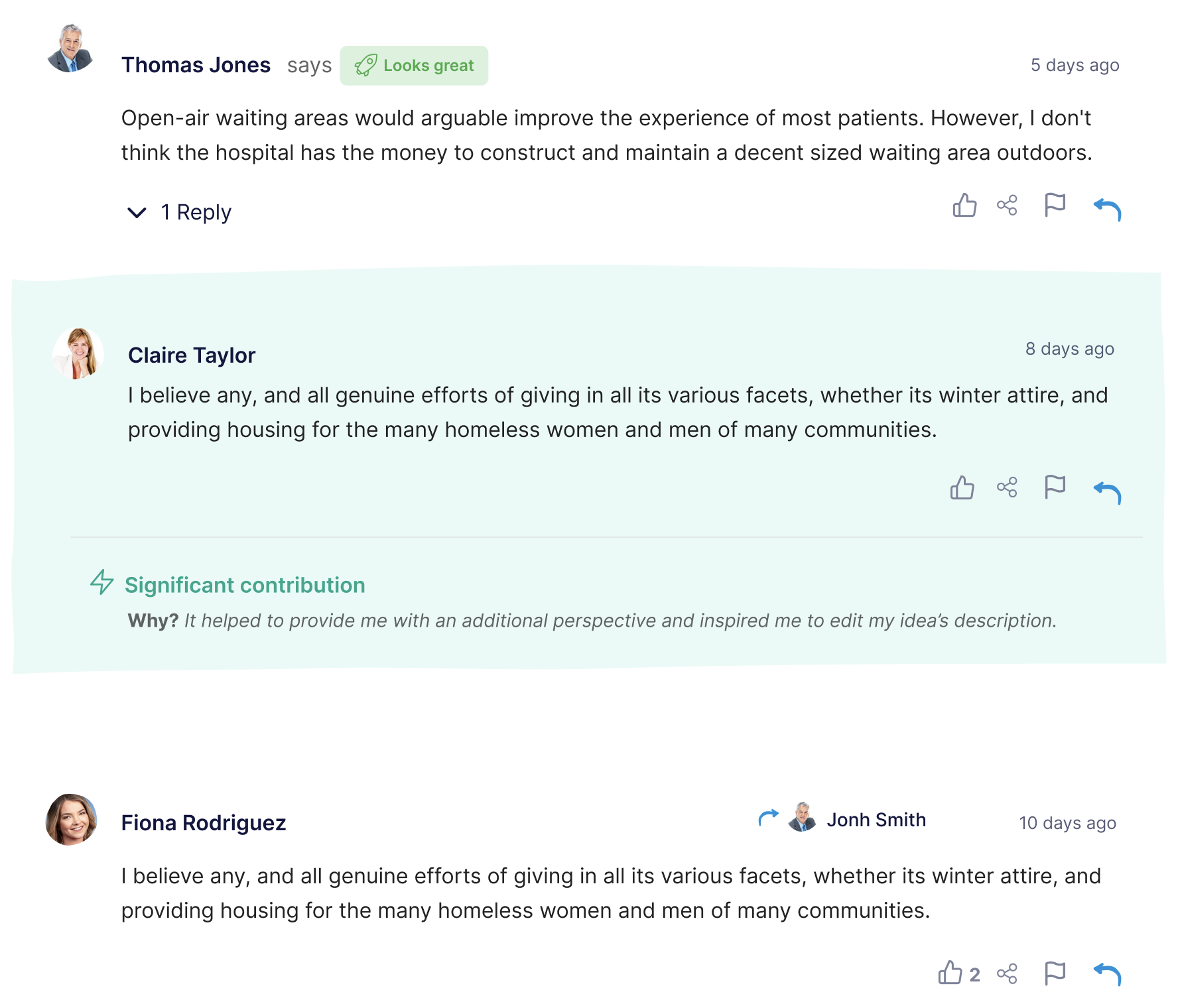
3. Idea Evaluation and Prioritization
After key contributors have worked with the author to refine an idea, it is sent for evaluation.
Idea evaluation is relatively simple: evaluators use a scorecard with a list of questions and a 1-10 response for each. They draw on the information provided by the author to score each question. Ideas that meet the minimum score are readied for prioritization and implementation, where they are prioritized from the highest to the lowest score.
Our advice — and this is what most companies fail to do — is to implement the systems and processes needed to evaluate ideas at scale.
In most large companies, evaluators are responsible for evaluating hundreds of ideas at a time. Without the necessary infrastructure to support a scalable evaluation process, evaluation consumes a tremendous amount of time and effort.
It’s common for companies to store innovative ideas in a spreadsheet and have evaluators communicate with idea authors via email. If evaluators want to approve or reject an idea, they must manually email authors and co-authors. If they wish to send an idea back for iteration, they must write an email detailing what needs to be iterated upon.
Evaluators spend less time evaluating ideas and more time sending emails.
Instead, companies with the most efficient innovation pipelines have processes in place to automate these repetitive tasks, enabling evaluators to assess hundreds of ideas with minimal time and effort.
InnovationCast Allows Companies to Manage the Evaluation Process At Scale
InnovationCast offers automation tools that help companies manage idea evaluation at scale through a structured stage gate process. This eliminates the need to spend hours writing emails and navigating back-and-forth communication.
Evaluators can select the approve or reject button, and InnovationCast automatically sends an email to the relevant author and co-creators. If they require an iteration, they can select the iteration button, choose from predefined feedback or write their own, and the appropriate users are notified.
Additionally, InnovationCast contains the scorecards needed to guide evaluators' decision-making and show them what factors to consider and data to pull in based on the specifics of the idea. We tailor these scorecards to align with your processes and innovation strategy during onboarding.
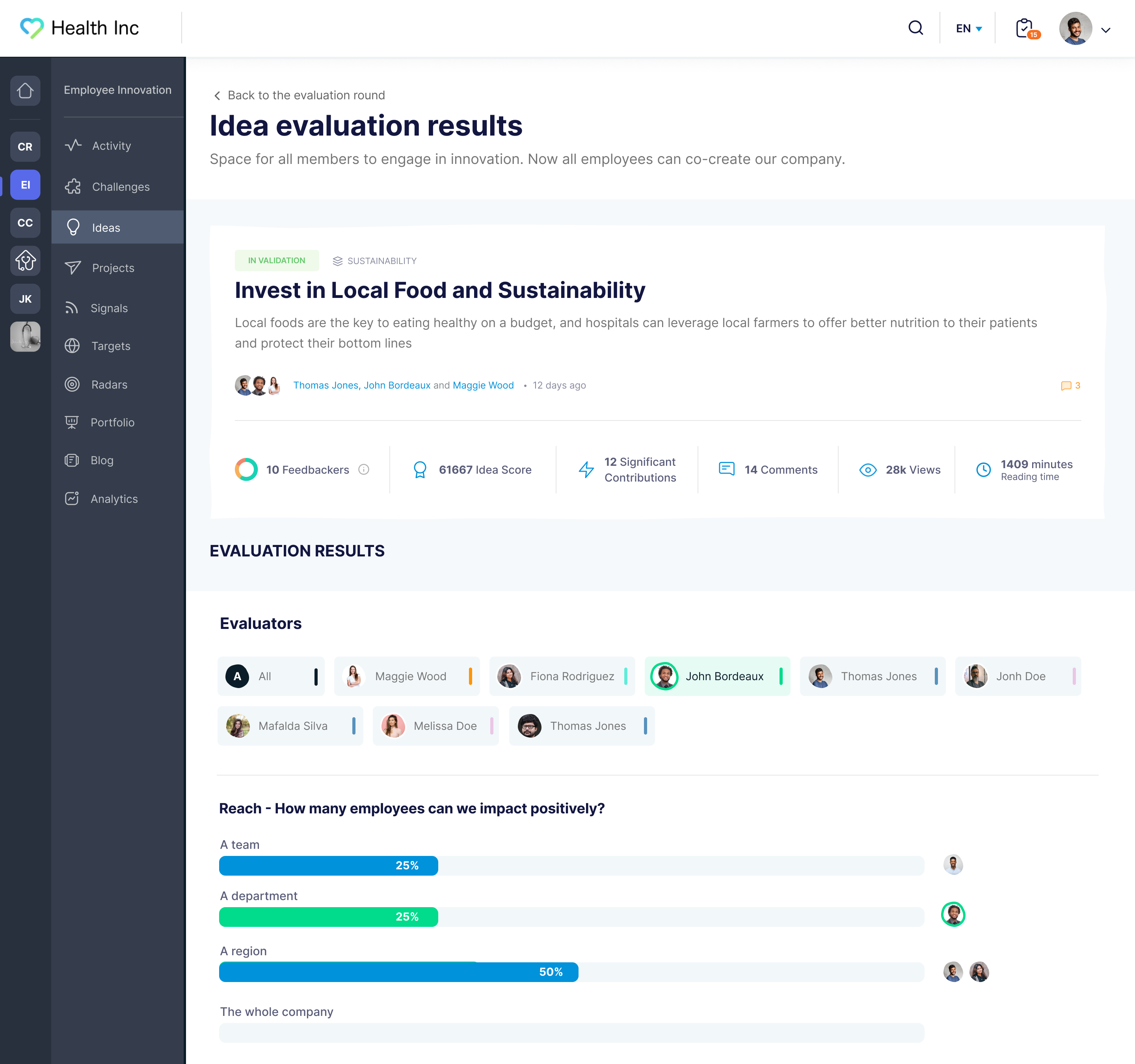
For idea prioritization, we can automatically send approved ideas to the project management office (PMO) for implementation, prioritizing from the highest to the lowest scores.
However, we also have dedicated idea prioritization voting tools, where we can send ideas to top management and key decision-makers first, have them vote on the implementation order, and then send them to the PMO. These automated workflows keep ideas moving through the innovation funnel with little delay.
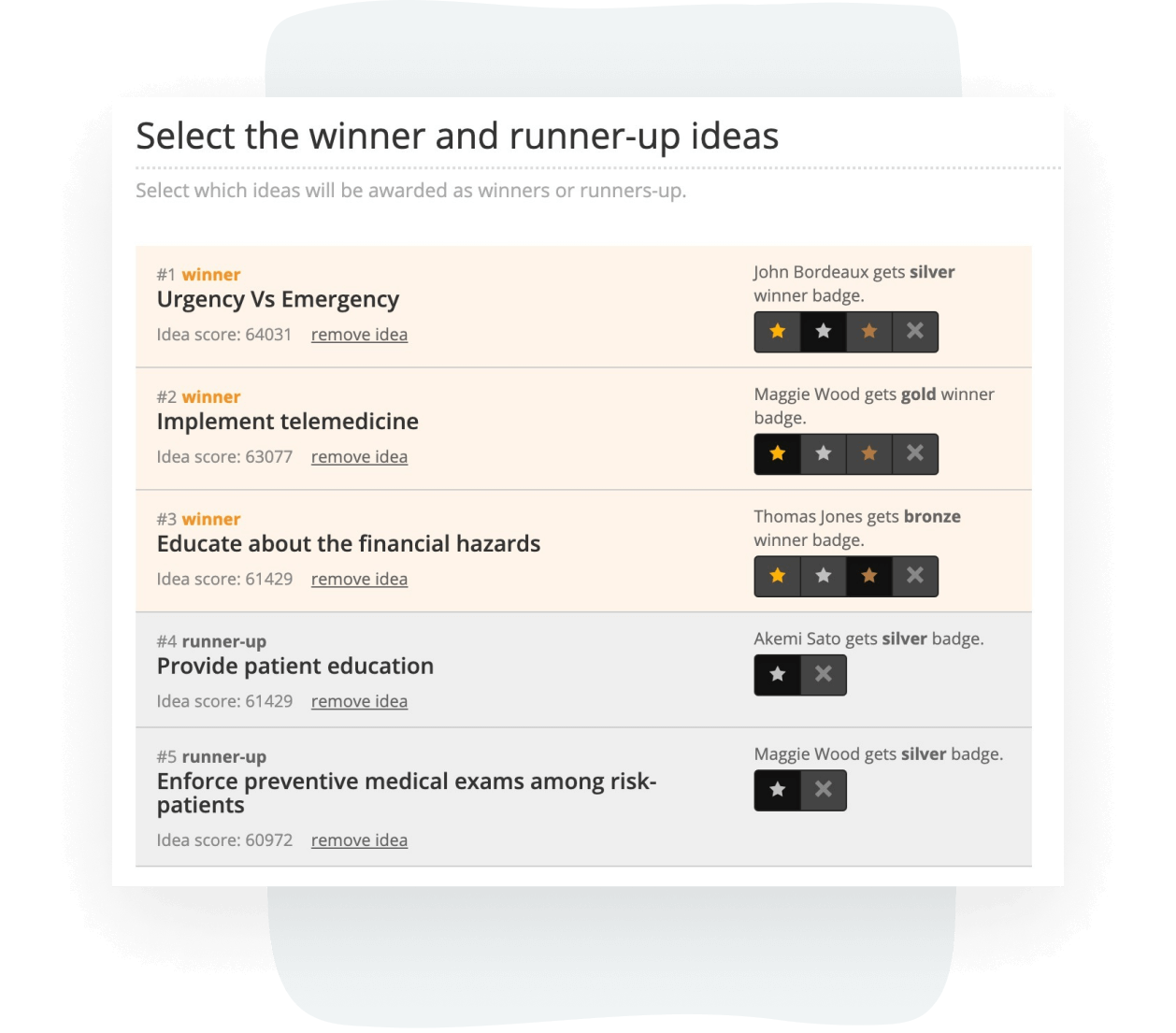
4. Idea Validation
Scorecards are an effective way to evaluate low-risk ideas with data to support informed decision-making. Evaluators can simply study the data and use it to answer questions in the scorecard.
However, some ideas may lack data or evidence to support their implementation because they are considered revolutionary and require substantial resources — this includes ideas for new products, business models, or market pivots.
For these high-risk, high-reward ideas, companies seek to mitigate risk factors through validation before committing resources to implementation. This is typically accomplished by assembling a validation team, which identifies key risk factors and then conducts experiments to test them.
We won’t discuss how to validate ideas in too much detail in this article, as we have a separate guide on the topic, which you can read here.
However, there are two mistakes we see companies make when validating ideas that set them up for failure:
They don’t guide validation teams on de-risking ideas: Validation teams usually consist of an engineer, designer, and marketer; they aren’t innovation managers and typically lack the expertise to manage innovation risk. Companies often leave teams to figure out the process themselves, which is a significant contributor to failed innovation projects. Instead, companies should provide teams with guidance on validating ideas.
Results aren’t organized in a central location for top management to see: Each validation team often works within its own set of tools, which top management typically can’t access. And when they can, they have to juggle between multiple different tools to see the results of each team. This makes it difficult to view the overall returns of the innovation portfolio, a common reason why top management cuts funding.
InnovationCast Walks Teams Through the Process of De-Risking Different Kinds of Ideas and Stores Results in the Reporting Dashboard
Drawing on 15 years of innovation and idea management experience, we designed validation workflows to help teams systematically de-risk ideas. This way, they have step-by-step guidance on the tasks they must complete; how to land on assumptions; what experiments to run (e.g., build prototypes or MVPs, run customer satisfaction interviews); prioritize risk indicators and KPIs; optimize the use of budget; and more.

We start by learning about your innovation strategy and strategic goals during onboarding and tailoring workflows to support the kinds of ideas you're collecting. There's no need for innovation managers to supervise every validation project personally.
However, we were careful to make InnovationCast as configurable as possible. If you want to customize validation workflows as you refine your innovation process, you can do so by adding, removing, or rearranging tasks, actions, buttons, or anything you wish.
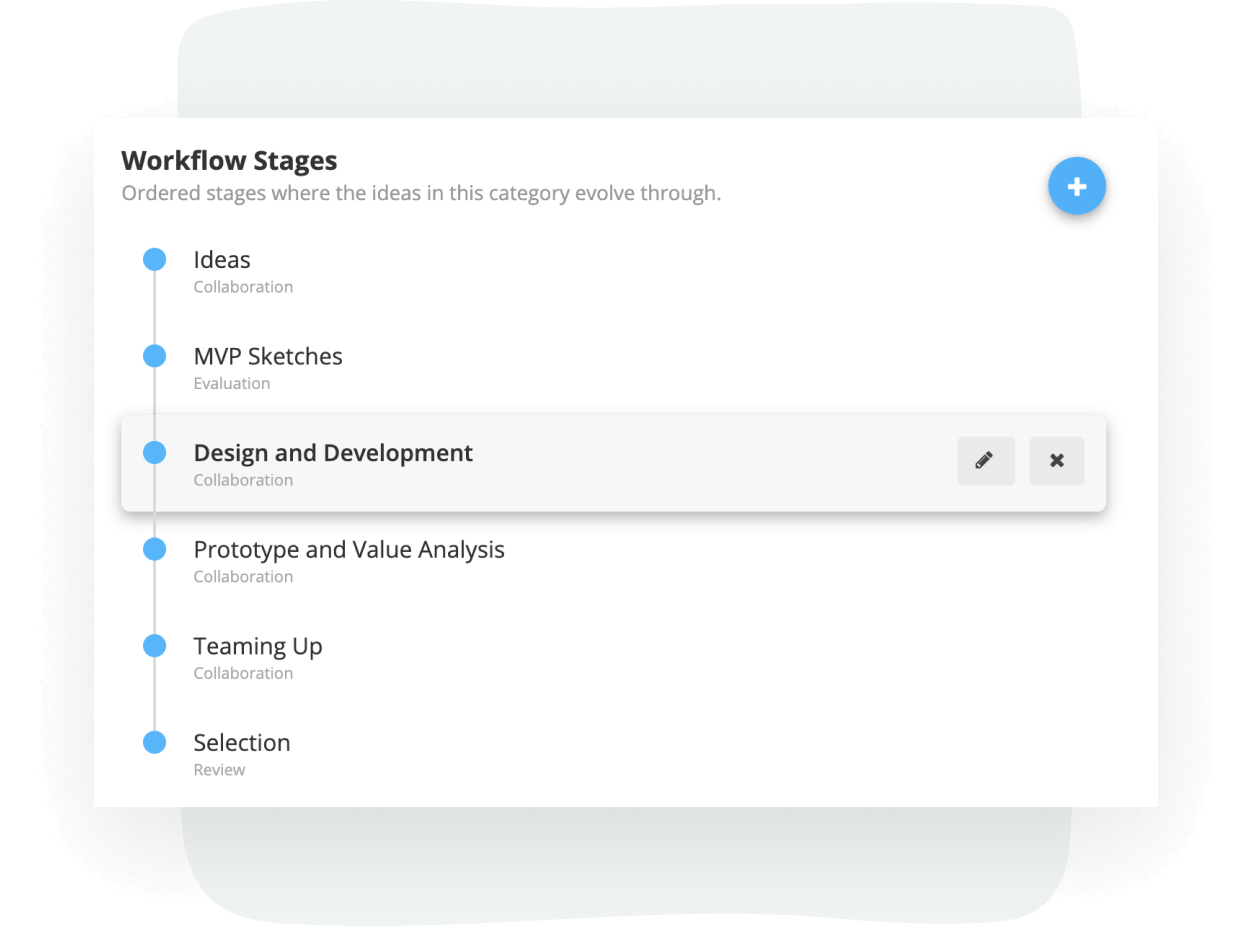
Then, as validation teams de-risk ideas, InnovationCast automatically pulls their results into the portfolio dashboard for stakeholders to see.

5. Idea Implementation
In most innovation programs, the PMO is responsible for implementation. Project managers working within the PMO will define deliverables, establish timelines and key metrics, and reach out to suppliers, among other tasks.
However, there are rare occasions when an idea is so revolutionary that it still carries significant risk and uncertainty, even after the typical validation stage is over, through to launch.
Consider Amazon’s Fire Phone. Despite initial internal excitement and significant investment, the product faced major challenges once it hit the market — ranging from unclear customer value and competitive advantage to limited real-time app support.
In such cases, the innovation team remains actively involved, working alongside the PMO to continue learning and refining the concept during execution. They will continue testing assumptions, gathering feedback, and pivoting to manage risk and gain more confidence in the idea.
Establish an Innovation Pipeline That Generates ROI with InnovationCast
Book a free demo to explore how InnovationCast can help you create an innovation pipeline that drives business results.

